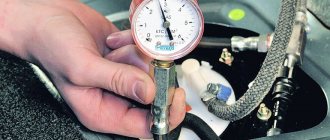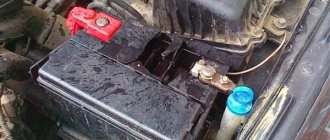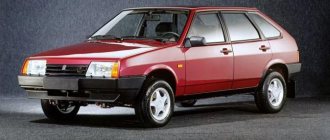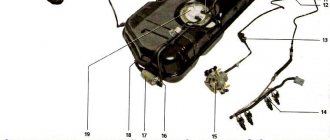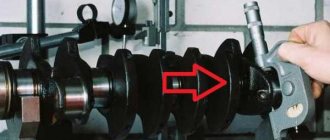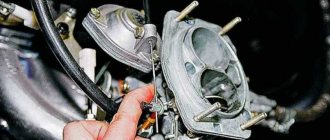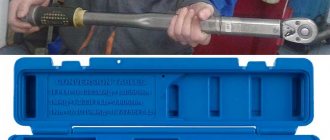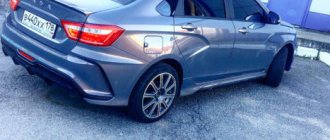The most prestigious and most affordable
The interior of the early "six" with wood trim.
The interior of the early "six" with wood trim.
The first “sixes” were distinguished by a luxury unprecedented in the USSR: rich seats with headrests, a “wood-like” film on the instrument panel, a shiny metal radiator grille and wheel arch edging.
The lanterns at the ends of the doors disappeared over time.
The lanterns at the ends of the doors disappeared over time.
Over time, many things were abandoned. Instead of flashlights, reflectors began to be installed at the ends of the doors, the “wood” in the interior, the chrome above the wheels and reflectors on the rear wings disappeared.
Simplified "six" of the early 1990s.
Simplified "six" of the early 1990s.
In the early 1990s, they even made “sixes” without moldings. True, not for long. Then the “six” ceased to be prestigious. Moreover, it was one of the cheapest cars.
Late VAZ-21063 with simplified finishing.
Late VAZ-21063 with simplified finishing.
Since the early 1980s, most of our cars have been equipped with less powerful engines: VAZ-21061 - a 1.45 liter engine with 77 hp, VAZ-21063 - 1.3 liter, 69 hp. The use of less powerful engines was partly due to export requirements. These are the versions that were quoted in many markets.
VAZ-2131 “Niva” (Lada 4×4)
At the end of 1993, at the pilot production plant of OJSC AvtoVAZ, the 5-door SUV of the Niva family was first put into production, which received the VAZ-2131 index. The car was developed as a modification of the 3-door VAZ-21213 model, but with a wheelbase extended by 50 centimeters and a longer body (4220 versus 3740 millimeters).
In addition to the elongated body, the car received an additional pair of side doors in the rear, which could not but affect the ease of boarding and disembarking passengers. The 5-door design of the car made it possible to easily fit in the back seat without crowding the front passengers. Thanks to the increased wheelbase, the VAZ-2131 SUV has become more stable on the road compared to the 3-door Niva, and the ride has also improved.
The trunk of the VAZ-2131 Niva SUV, like the 3-door model, is located inside the cabin immediately behind the rear seats. Thanks to the use of reinforced springs and shock absorbers, the suspension can accommodate up to 300 kilograms of cargo, and the total load capacity has increased from 400 to 520 kilograms compared to the VAZ-2121 model.
Starting from 2006, the VAZ-2131 car, like the entire Niva family of cars, was renamed in accordance with the GM-AvtoVAZ joint venture agreement; from that moment on, the SUV received the name Lada 4×4 5D (and the 3-door model Lada 4×4). At the beginning of February (5th, to be precise) 2009, the 100,000th car with a 5-door body Lada 4×4 5D (VAZ-2131) left the assembly line; this SUV has proven itself excellent both on highways and on dirt roads, it capable of overcoming water obstacles up to half a meter deep, snowy and sandy areas, as well as marshy and clayey areas.
The VAZ-2131 is available in three trim levels and as of January 2022, the price of a Lada 4×4 car with a 5-door body is 500 thousand 700 rubles, taking into account the maximum benefit (without it 520700 rubles) for the configuration. The maximum configuration is not much more expensive and will cost from 532 thousand 700 rubles with the maximum benefit or 552700 rubles without it.
On request for a VAZ-2131 car, you can install an additional front guard, the so-called “kenguryatnik”, a bracket for a spare wheel on the fifth door, fog lights, power steering, air conditioning, you can even install a sunroof on the roof of the car, but for an additional fee. In addition, a 1.9-liter Peugeot diesel engine can be installed upon request, at least this was possible before; at the moment, the VAZ-2131 SUV is mass-produced only with a 1.7-liter 8-valve engine with a capacity of 83 horsepower.
The most successful rally car of the USSR
Rally "treshka" with a 1.6 liter engine at the Akropolis rally.
Rally "treshka" with a 1.6 liter engine at the Akropolis rally.
The best result in world-class rallies in the entire history of participation of Soviet athletes in them was sixth place in the overall standings of the Akropolis rally in 1976. The crew of Stasys Brundza/Arvydas Girdauskas competed there in a VAZ-2103 with a 1.6 liter engine with two horizontal Weber carburetors. That is, a hybrid of “three rubles” and “sixes”.
Niva suspension lift yourself drawing
We will tell you how to properly perform tuning modifications in this material.
Do-it-yourself elevator - drawings, diagrams, sizes, types of kits. Lifting varies in the degree of intervention in the standard structure. For some, it is enough to raise the SUV by a few centimeters, and for others by as much as 20.
Extreme tuning – maximizing cross-country ability for traveling on severe off-road conditions.
- Regular jack Hijack jack Spring puller Balloon wrench Set of socket heads with ratchet Set of open-end wrenches Pry bar Wooden block (stump)
It is advisable to perform such work with a partner. First of all, it's safer. Secondly, some lifting work is performed with four hands. Let's take the front suspension as an example.
Specifications
The parameters and characteristics below refer to the first produced version, which came off the assembly line in 1977. There were a lot of modifications, and every time something changed for the Soviet SUV.
- The Niva SUV, an all-terrain vehicle, has 3 doors.
- Load-bearing body.
- Body type – hatchback.
- Drive – full, permanent.
- The gearbox is four-speed.
- The transfer case is two-stage.
- Center differential lock.
- Ground clearance – 220 mm.
- The approach angle is 32°, the departure angle is 37°.
- Wheelbase - 2.2 meters.
- Fuel tank - 42 liters.
- Engine – petrol, volume 1580 cm³.
- Engine power – 80 horsepower.
- Length – 3740 mm.
- Width – 1680 mm.
- Height – 1640 mm.
- Weight – 1150 kg.
Installation of a ready-made lifting kit for Niva 21212
To understand the process, let’s look at the geometry of the suspension on NIVA SUVs (front axle). The drawings clearly demonstrate the position of the elements relative to each other. If you organize an elevator only by increasing the length of the spring, its bending radius decreases, and lateral loads appear on the mountings of the levers. To compensate for this side effect, spacers are used: under the spring cup and ball joint.
The standard version shows that the axle shaft (CV joint) is located virtually parallel to the ground. The spacer is installed between the spring and the lever. The radius of curvature of the elastic element is small, the softness of the suspension is maintained. The fastening is reliable, there is no backlash. Disadvantage - the additional element adds unsprung masses (aluminum parts can be used to reduce weight). The spacer is installed between the cup and the spring. There are no unsprung masses, the radius of curvature of the elastic element is even smaller than in the previous version. The disadvantage is that the attachment of the additional element is not so reliable.
In all cases, the elevator changes the position of the axle shaft. The load on the tripods (gimbals) increases. When lowering the suspension, the travel of the upper arm to the bump stop decreases. To restore the geometry, a spacer is installed under the upper ball joint. Factory kits are designed taking into account all the design nuances of the front axle and rear axle.
The set includes:
- Drawings for correct installation Spacers Extended shock absorbers New trailing arms for the axle Extended panhard rod New cups and springs
Replacement process: To install the lift kit, a garage with a pit and a standard set of repair tools are enough. Those who independently service LADA 21214 know what we are talking about. Preparation of the front axle is described in the Niva budget elevator section. Only when installing the kit is the steering knuckle removed completely. If you manage to fix it without removing the CV joint, good. Usually it is completely separated from the suspension.
Next, dismantle the lower spring cup and install three ring spacers under it. There are no more modifications to this lever. An enlarged support ring is installed on top of the elastic element.
To compensate for the divergence of the levers, we mount a spacer under the upper ball mount. Since all the parts are from the same set, the sizes are synchronized.
This element is the most responsible. If the geometry “floats”, the front suspension travel will be disrupted. To fine-tune the height, the monolithic upper ball spacer can be replaced with stacked washers. By selecting the quantity, you adjust the parameters of the front axle, just like on a rally car.
If the kit includes new shock absorbers, they should be installed. On standard ones, the rebound stroke may not be enough, and your 21212 will squirm on potholes. The rear axle is completely removed, especially if new support cups are welded under the springs. The eyelets for the levers remain standard, the extended parts from the kit have standard fastenings. Depending on the size of the front axle lift, you may be limited to raised cups, or add spacers for the springs. It is better to choose a customizable Panhard rod. You can adjust its length when changing the clearance height.
Modifications
Probably, in the history of the automobile industry you will not find another car that would have so many modifications. This is a Niva pickup version, a right-hand drive model, a super-all-terrain version, and a special convertible version. There is a version of a car with a diesel engine, which was exported and the engine was from Peugeot; even an amphibian based on the Niva was produced. There were a lot of improvements during the release of the Russian SUV.
The extended Niva is also one of the modifications of the short VAZ-2121. There were also many five-door versions, this was an ambulance car, and many similar directions. “Niva” is long or short – a comparison should put everything in its place.
Eventually
As a result, everything comes down again to tasks. If the goal is to get there and there is only one driver and passenger in the cabin, then the short Niva wins, it is light, small, nimble due to its weight, maneuverable, and can jump on any curb in the city. It’s like a small car in size, it’s easy to park, and even if there are very small children in the family, then the three-door version is just right, because the baby won’t fall out or accidentally open the door. On the five-door version there is no automatic locking, and a child can easily open the door. This is such a lyrical digression.
Short or long Niva - which is better? If comfort comes first, if the volume of the fuel tank, a large trunk and the convenience of rear passengers are important, but cross-country ability is a slight disadvantage, then you should give preference to a five-door car.
It would be best to take both cars for a test drive, drive each, sit inside the cabin both as a passenger and as a driver, and only then make a choice.
Patency
There are times when, in terms of cross-country ability, it’s impossible to say one hundred percent which car is better, the short Niva or the long one, there are different reviews. It all depends on weather conditions, how many people are in the car, what kind of tires it costs. If we consider the situation that two cars are driving through shallow mud, then which Niva - short or long - is better? Most likely, the car that weighs more will pass, and the short car will get stuck. She won't have enough weight. But in those situations where there are no stones, or logs, or any obstacles, the short version will rush through due to its 220 mm wheelbase, and the long version, which is 50 cm longer in wheelbase, can land on an obstacle. In normal and dry weather conditions on dried mud, which is better - a short Niva or a long one? Most car owners believe that the VAZ-2121 will still win in terms of cross-country ability.
History of creation
The initiative to develop a car capable of overcoming off-road conditions belongs to VAZ designer V. S. Solovyov. First of all, this was supposed to be a vehicle for use in any conditions by residents of villages and hamlets. Since at that time there were no analogues of this type, the emphasis was placed on this.
You will be interested: How dangerous is the new coronavirus?
In April 1972, the first test car was presented to the world. The car got its name not thanks to the fields, as many people think. The name was based on the first letters of the names of the children of designers Prusov and Solovyov. Natalya, Irina, Vadim and Andrey: the combination of letters resulted in “Niva”.
The design came from the VAZ-2106. “Niva” is similar to the “six” both externally and inside the car.
From 1972 until the start of mass production, many Niva prototypes were produced, they were tested, many tests were carried out, long runs were organized to identify shortcomings. To evaluate and compare the car with existing analogues in the world, such cars as UAZ-469, Land Rover and Range Rover were used for testing. In 1975, an official decree was signed on the release of an SUV.
Which one is better?
Short or long Niva? This question probably comes to mind for many who are considering buying this Russian SUV.
It is important for yourself to emphasize what tasks are set for the car during its operation. After all, each “Niva” has its own characteristics. To do this, you need to consider the advantages or advantages of the short version and similarly consider the advantages of the long VAZ-2131.

